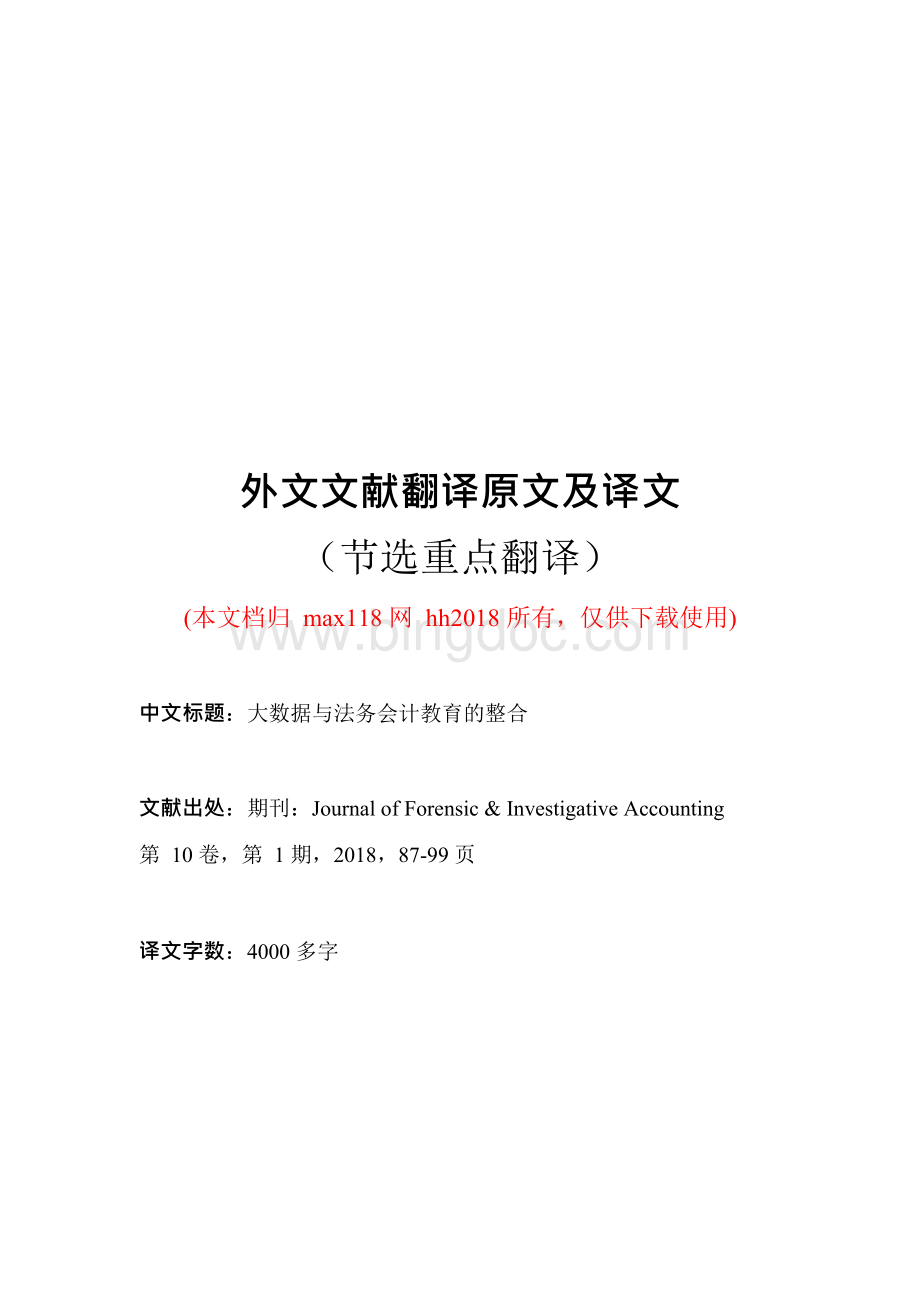法务会计外文文献翻译中英文2018Word下载.docx
《法务会计外文文献翻译中英文2018Word下载.docx》由会员分享,可在线阅读,更多相关《法务会计外文文献翻译中英文2018Word下载.docx(19页珍藏版)》请在冰点文库上搜索。

中文标题:
大数据与法务会计教育的整合
文献出处:
期刊:
JournalofForensic&
InvestigativeAccounting
第10卷,第1期,2018,87-99页
译文字数:
4000多字
原文
TowardtheIntegrationofBigDataintoForensicAccountingEducationZabihollahRezaee,JimWang
Introduction
Informationtechnology(IT)advances(e.g.,cloudcomputing,electronicsocialmedia,analytics)intherecentdecadesprovideorganizationsofalltypesandsizeswithanunprecedentedamountofdataandinformationavailability.TheseorganizationsareprogressivelymovingintotheageofBigDatathatisdescribedbyGartner(2014)andVasarhelyietal.,(2015)ashigh-volume,high-velocity,andhigh-varietyinformation,thatistypicallyprocessedelectronicallyandintendedtoimprovedecisionmaking.ArecentsurveyofFortune1,000firmsconductedbyVantagePartner(2016)indicatestheincreasinguseofBigData.Approximatelyfifty-fourpercentofthesefirmshaveestablishedrolesofChiefDataOfficerstoincreaseinvestmentinBigData,fastertime-to-answer,fastertime-to-decision,fasterspeed-to-market,andobtaingreaterinsightsintobusinessandcustomers.Forensicaccountingalsohasemergedasanimportantpracticeforaccountingfirms,whichincludevariouspracticessuchasfraudexamination,investigationofcorruptionandbribery,businessvaluation,beinganexpertwitness,cybercrimemanagement/cybersecurity,andlitigationsupport(Crumbleyetal.,2015).ThisarticleexaminestheintegrationofBigDatainto
forensicaccountingeducationby:
(1)reviewingpriorliteraturetoidentifyalistofBigDatatopicsorcoursesthatcouldbeincorporatedintoforensicaccountingeducation;
(2)investigatingtheforensicaccountingsyllabiofuniversitiesworldwideintheircoverageofBigDatatopics;
and
(3)presentingsuggestionsforthedevelopmentofforensicaccountingcurriculumwithBigDataanddataanalyticsfocus.
Forensicaccountantsarenowfacingthehugeamountofbothstructured(e.g.,generalledgerortransactiondata)andunstructureddata(e.g.,e-mail,voice,orfree-textfieldsinadatabase),togetherwithanincreasingamountofnontraditionaldatasourcessuchasthird-partywatchlists,newsmedia,free-textpaymentdescriptions,emailcommunications,andsocialmedia.DataanalyticswiththeuseofBigDatahasbeenemployedtotransformunstructureddataintouseful,structured,andrelevantinformationfordecisionmaking.Forensicaccountingservicesareoftenperformedbyindividualswithmultidisciplinaryknowledgeandexperienceinaccounting,technology,andlawswhoareprofessionallyskepticalinaskingrightquestions,utilizingdatascience,anddatamanagementexpertisetotranslatequestionsintomeaningfulanalyticsandusesystemsandITinfrastructures(EY,2014;
EY,2016).EY(2016)documentstwofactorswhichincreasetheuseofdataanalytictoolsbyforensicaccountantsintheirinvestigations.First,cyberbreachescauseillicittransferringof
funds,disruptcriticaloperations,stealintellectualproperty/confidentialpersonaldata,andothercriticaldigitalassets.Second,fraudrisksincreasebecauseofinsiderthreatstriggeredbymaliciousinsiderstomanipulateordestroydata,perpetratefraud,stealintellectualproperty,engageinunauthorizedtrading,espionage,orinformationtechnologysabotage.
PriorresearchsuggeststhatthesupplyofBigDataprofessionalsisinadequatedespiteanincreasinguseofBigDatainforensicaccountingpractices.Forexample,DongLaney(2012)forecastsashortageofdataspecialistsasitisanticipatedthattheneedfordatascientistsisgrowingfast,andthereisapredictedshortageofabout100,000-plus-personanalytictalentsby2020intheU.S.McKinseyGlobal(2011)predictssignificantshortageof1.5millionprofessionalswithanalyticalexpertiseandtheskillstounderstandanduseBigDataindecision-makingprocesses.Wixometal.,(2014)findgrowingmarketdemandforstudentswithBusinessIntelligence(BI)andBusinessAnalytics(BA)skillsetswiththeanticipationthatdemandforBigDataprofessionalswillriseinthefuture.Recently,PwC(2017,p5)estimates“themarketanalysiscallsforannualjobopeningstorisesteadilyto2.72millionpostingsfordatascienceandanalyticsrolesin2020.”InChina,thereisanestimateddemandof1.8millionBigDataprofessionalsinthenextthreetofiveyears,1.5millionmorethancurrentsupply(GlobalTimes,2017).
AshortsupplyofBigDataprofessionalsraisesthequestionasto
whetherthereisadequatetrainingrelatedtoBigDataattheundergraduate/graduatelevelintheforensicaccountingeducation.Thisarticleaddressesthisquestionby
(1)investigatingthestatusoftheBigDataintegrationintoforensicaccountingcoursesandprograms;
and
(2)examiningthetopicalcoverageofBigDatainforensicaccountingcourses/programs.OuranalysesshowthatthecoverageofBigDatacoursesinforensicaccountingeducationinChinacurrentlylagsbehindtheUnitedStates(U.S.),Canada,andotherEnglishspeakingcountries.AnecdotalevidencefromWangetal.,(2016)showsthatthereareonlynineteenuniversitiesinChinawithforensicaccountingcoursesorforensicaccountingprograms,andonlythreeuniversitieshaveastandaloneBigDatacourseoutofthenineteenuniversities.ThissituationcontrastsdramaticallywiththeU.S.,whereamongninety-sevenuniversitiesofferingforensicaccountingprograms,forty-threehaveastandaloneBigDatacourse(SedaandKramer,2014).Asaresponsetotheincreasingdemand,anaccreditationbodysuchasAssociationtoAdvanceCollegiateSchoolsofBusinessandaccountingfirmsproposedtoincorporateBigDatarelatedskillsandknowledgetopreparestudentsintheircareer(AACSBA7,2014).PricewaterhouseCoopers(2015)recommendedadata-drivenaccountingcurriculumaspartofitsefforttofacilitatethecurriculumdesignanddeliverywithchallengesofIT,BigData,anddataanalytics.Theresultssuggestmoreresourceinputintothe
forensicaccountingprograms,particularlyatundergraduatelevel,toincorporateBigData/dataanalyticsintothecurriculum.ThisresearchmakesanimportantcontributiontotheforensicaccountingeducationliteraturebyexaminingtheissueofintegrationofBigData/dataanalyticsintoforensicaccountingcoursesandthusthebusinesscurriculum.
LiteratureReview
Severalstudies(e.g.,Chen,Chiang,andStorey,2012;
Cao,Chychyla,andStewart,2015)provideanoverviewofBigDataanditsimplicationsinauditanalytics.Chen,Chiang,andStorey(2012)arguethatBigDataanalyticscanimprovetheeffectivenessoffinancialfrauddetection.Forexample,ameta-learningframework,whichisbasedonabusinessintelligenceanddesignscienceapproach,canachievea79.2percentdetectionrateoftestinstancesinmostlegitimateandfraudcases.Thisdetectionishigherthanthelessthanseventypercentdetectionrateoffinancialfraudswithtraditionalmethods.Cao,Chychyla,andStewart(2015)proposethatBigData/analyticscanimprovetheefficiencyandeffectivenessoffinancialstatementaudits.Auditorsarecurrentlyaccessingtheincreasingamountofvariousinformationsuchasnews,audioandvideostreams,cellphonerecordings,socialmediacomments,becauseofdigitalizationandtheabilitytostorepetabytesofdata.ThisincreaseindataprovidesauditorswithanopportunitytouseBigDataanalyticsinriskassessment,substantiveanalyticalprocedures,collection
ofauditevidence,aswellasobtainingauditconfirmationofevents,transactions,andreportingelements.Auditorscanuseanalyticstoprocessthevoluminousinformationofclients’pastactivitiesoroutcomesofpastauditstoidentifyfraudrisksandtodirectauditefforttowardsfrauddetection.Forexample,auditorsincludingforensicaccountantscanusestatisticalrelationshipsbetweenbusinesselementsandprocessestodetectirregulareventsorfrauds.
BusinessesandregulatorsarealsousingBigDataanddataanalyticsindetectingirregularities,non-compliancewithapplicablelaw,rules,regulations,andstandards.Forexample,internalauditstaffoftwoinsurancefirms,BlueCrossandBlueShield,usedataanalyticstodetectduplicateinsuranceclaimsamongmillionsofclaimseachmonth.(Cao,Chychyla,andStewart,2015).Withthevoluminoustime-stampeddatafromthirteennationalequityexchanges,whicharearoundonebillionrecordseachday,theSECusesBigDataanddataanalytics,labeled“RobotCop,”toidentifysecuritieslawviolations,andirregularitiesinthepreparationoffinancialstatements,issuerreporting,andauditfailures(Forbes,2013).BrownLiburd,Issa,andLombardi(2015)discussthechallengesinincorporatingBigDataandauditanalyticsintoauditstrategiesandpresentthebehavioralimplicationsofBigDataforauditjudgmentsthataffectauditquality.TheuseofbothBigDataandDataSciencemethodsarechangingthewayauditorsgatherandassessaudit
evidence.BigDataisexpectedtogrowexponentiallyandthus,forensicaccountantsshouldproactivelysearchforpatterns,includingirregularities,inBigDataandassessandmanagetheirriskprofileindetectingfraud.
IssaandKogan(2014)pointoutthechallengeofuseofBigDataanddataanalyticsbyauditors.Useofdataanalyticscanbeoverwhelmingforauditorsbecauseofthevoluminousoutputofdataresultingfromanalysis.Ontheonehand,irrelevantinformationcanpotentiallylimitthevalueofuseofBigDataanddataanalyticsforauditors.Ontheotherhand,auditorsneedtheknowledgeandskillstoclearlyunderstandthequalityandrelevanceofthedatatomakeprofessionaljudgments.